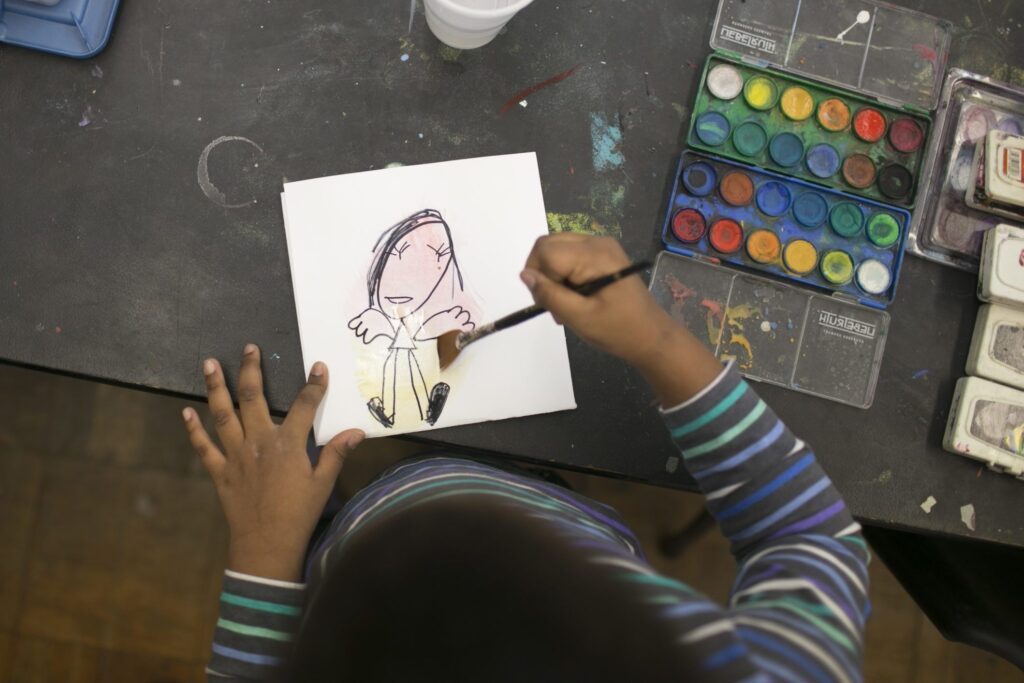We know places that let kids explore arts are vital parts of a learning network. We also know that art is every bit as important as STEM for instilling skills such as problem solving and imagination. But can after-school arts programming do even more? A recent report from the College & University Research Collaborative finds that enrolling more kids in after-school arts classes is associated with a decline in juvenile crime rates.
The researchers analyzed education, crime, and census data from 39 Rhode Island cities for five years. Two of the three statistical models showed that participation in educational after-school activities was associated with lower juvenile crime rates in the same year. In one of the statistical models, a 10 percent increase in participation was associated with a 4 percent decrease in juvenile crime rates.
Higher participation rates in lower-income towns—towns with median incomes less than the area’s median income—was slightly more effective: a 10 percent increase in participation meant a 5.4 percent decrease in juvenile crime.
The report points out that much more research is needed to address remaining questions. For example, do the effects of the programming last? Furthermore, there’s no data on participation rates in after-school programs that are specifically arts-based; therefore, the analysis focuses on broader after-school activities with more in-depth interviews, untangling the effects of arts programming specifically.
Researchers found arts-based programming in many cases had turned around participants’ lives. What we do know already, though, is that kids from low-income families have less access to quality after-school programming, even though they’re the ones who need it most. For one thing, heading to a dance program or theater rehearsal is an alternative to spending those after-school hours at home in front of the television or in neighborhoods that may be affected by crime or drug use. Nobel Prize−winning economist James Heckman found in a 2006 study that following early education with after-school programs can cut young people’s chances of starting drugs by one-half.
As one student who is part of Rhode Island’s Everett: Company, Stage & School explains in the report, “By middle school I slipped into the pattern of behavior typical to the youth surrounding me; I joined a gang and began engaging in risky behaviors. [Then] my best friend and I discovered break dancing, and somehow also found Everett. . . . From preparing for shows . . . across the state to being exposed to places and people I otherwise would never know, these experiences changed the course of my life.”
Beyond keeping kids in safe environments, after-school arts programs give low-income kids similar chances to learn and explore their own interests that their higher-income peers have been receiving at origami camp or during saxophone lessons for years. By the time kids born into poverty reach sixth grade, they will have spent approximately 6,000 fewer hours learning than their wealthier counterparts. (If you do the math that’s approximately five school years.)
Approximately one-half of those missed learning hours come from after-school and extracurricular activities that their higher-income peers have been partaking in since day one. Those hours have a snowball effect, and that achievement gap too often carries on throughout high school and beyond.
Of course, it’s about more than only hours put into learning. The more difficult challenge is filling those hours with quality programming that will make a difference. Through interviews and observations, the Rhode Island researchers found arts-based programming in many cases had turned around participants’ lives. In addition, an emphasis on retention, an evolution of youths’ roles, and family engagement were keys to a program’s success. The researchers also found that programs integrating skill-based training or providing resources to help students graduate, apply to college, or earn scholarships are critical to a program that works.
The Wallace Foundation also investigated what factors draw low-income tweens to after-school art programs. Through hundreds of interviews with students, the report found instructors who are professional artists and programs taking place in dedicated, welcoming spaces are among the most important elements for attracting students. Learning Labs in libraries and museums, such as those in Pittsburgh and 23 other cities, are taking those elements to heart.
The Manchester Craftsmen’s Guild also embraces those elements. Bill Strickland, who founded the guild in 1968 in Pittsburgh, talked with us last winter about the success of his growing urban art centers. He touched on how the arts engage kids in learning in an intrinsic way. In fact, we learn exclusively through creative activities for our first five years of life.
“I think it’s how we’re built as humans. Creative activity releases a part of your consciousness that is essential to mental and physical health,” he said.
Sure, art instills 21st-century skills employers will be looking for down the line, such as imagination or divergent thinking. But kids don’t love paper mache because it teaches them the basics of structural engineering; rather, they’re drawn to it because there’s something fundamentally human about ideas flowing into your hands and creating art.
All kids deserve a chance to tap into that human experience, whether it be through programs in Pittsburgh that teach audio recording,or photography, or ones that encourage art inspired by social change. Strickland explained—and the Rhode Island report noted—that providing kids with a creative outlet in the right space can create enormous potential for learning and for their lives.
“Many of these kids are coming from environments where there are no parents or only one parent. They’re dealing with welfare, drugs, poverty and violence,” Strickland explained. “We create an environment for them that says, ‘We care about you. We’re not going away. We’re here for the long term. You’re part of us, now, so let’s go.’”
